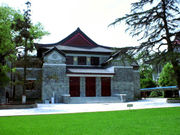
"I will skip through time and space / So you can find a sense of place"
-- Jamie JanczakÕs project: "Dr. Seuss at Oxford"
THE ORIGIN OF UNIVERSITIES
Shangyang, "higher school," China, established sometime during the Yu period: 2257-2208 BC
Imperial Central School, established sometime in Zhou Dynasty: 1046-249 BC
("The
early Chinese state depended upon literate, educated officials for operation
of the empire, and an imperial examination was established in the Sui
Dynasty (581–618) for evaluating and selecting officials from the
general populace.
Takshashila University, Taxila, Pakistan, 7th c. BC
Nalanda University, Bihar, India, 5th c. BC "famous center of Buddhist scholarship [attracting] scholars from East, Central, and South-East Asia and China :



Plato's Academy, Athens, 387 BC
Najing University, China, 258:



University of Salerno, Italy, 9th. c., "growing out of a Benedictine monastery"
University of Magnaura, Constantinople, 848
Al-Azhar University, Cairo, Egypt, 988:



DEGREE-GRANTING UNIVERSITIES
"Many
of the medieval universities in Western Europe were born under the
aegis of the Catholic Church, usually as cathedral schools or by papal
bull as Studia Generali. In the early medieval period, most new universities
were founded from pre-existing schools, usually when these schools
were deemed to have become primarily sites of higher education. Many
historians state that universities and cathedral schools were a continuation
of the interest in learning promoted by monasteries.

those in bold are represented on and in the Main Building (the Tower) of the University of Texas:
*University of Bologna, Bologna, Italy, founded in 1088
* University of Paris, Paris, France, founded c. 1150 (now split between several autonomous universities)
* University of Oxford, Oxford, England, founded before 1167
* University of Cambridge, Cambridge, England, founded c. 1209
* University of Salamanca, Salamanca, Spain, founded in 1218
* University of Montpellier, Montpellier, France, founded in 1220
* University of Padua, Padua, Italy, founded in 1222
* University of Naples Federico II, Naples, Italy, founded in 1224
* University of Toulouse, Toulouse, France, founded in 1229
* University of Siena, Siena, Italy, founded in 1240
* University of Coimbra, Coimbra, Portugal, founded in 1290 in Lisbon
* Universidad Complutense de Madrid, Madrid, Spain, founded in 1293 in Alcal de Henares
* University of Lleida, Lleida, Spain, founded in 1300
* University of Rome La Sapienza, Rome, Italy, founded in 1303
* University of Pisa, Pisa, Italy, founded in 1343
* Charles University of Prague, Prague, Czech Republic, founded in 1348
* University of Pavia, Pavia, Italy, founded in 1361
* Jagiellonian University, Krakw, Poland, founded in 1364
* University of Vienna, Vienna, Austria, founded in 1365
* University of Pcs, Pcs, Hungary, founded in 1367
* Ruprecht Karls University of Heidelberg, Heidelberg, Germany, founded in 1386
* University of Ferrara, Ferrara, Italy, founded in 1391
* University of Wrzburg, Wrzburg, Germany, founded in 1402
* University of Leipzig, Leipzig, Germany, founded in 1409
* University of St. Andrews, St. Andrews, Scotland, founded in 1412
* University of Rostock, Rostock, Germany, founded in 1419
* Catholic University of Leuven, Leuven, Belgium, founded in 1425,
* University of Poitiers, Poitiers, France, founded in 1431
* University of Glasgow, Glasgow, Scotland, founded in 1451
* University of Istanbul, Istanbul, Turkey, founded in 1453
* Ernst Moritz Arndt University of Greifswald, Greifswald, Germany, founded in 1456
* Albert Ludwigs University of Freiburg, Freiburg, Germany, founded in 1457
* Basel University, Basel, Switzerland, founded in 1460
* Uppsala University, Uppsala, Sweden, founded in 1477
* Eberhard Karls University of Tbingen, Tbingen, Germany, founded in 1477
* University of Copenhagen, Copenhagen, Denmark, founded in 1479
* University of Aberdeen, Aberdeen, Scotland, founded in 1494
* University of Santiago de Compostela, Galicia, Spain, founded in 1495
Outside Europe
Real
y Pontificia Universidad de Mxico, today the National University
of Mexico (UNAM) founded in 1551 ....inspired by the University
of Salamanca.
ÒUNIVERSITYÓ etymology: [É L. {umac}niversit{amac}t-, {umac}niversit{amac}s, (1) the whole, entire number, universe, (2) in later and medi¾val Latin (chiefly in legal use), a society, company, corporation, or community regarded collectively; f. L. {umac}niversus (see UNIVERSE).]
I. 1. a. The whole body of teachers and scholars engaged, at a particular place, in giving and receiving instruction in the higher branches of learning; such persons associated together as a society or corporate body, with definite organization and acknowledged powers and privileges (esp. that of conferring degrees), and forming an institution for the promotion of education in the higher or more important branches of learning; also, the colleges, buildings, etc., belonging to such a body. In recent use, const. without article: at (or to) university, etc.
Sometimes, especially in former use, synonymous with college: see COLLEGE n. 4c. OED
ÒuniversityÓ Institution of higher learning. Universities grew from the studia generalia of the 12th century, which provided education for priests and monks and were attended by students from all parts of Europe. In the 11th century, Bologna became an important centre of legal studies. Other great studia generalia were founded in the mid-12th century at Paris, Oxford, and Cambridge.
"university" World Encyclopedia. Philip's, 2005. Oxford Reference Online. Oxford University Press.
Wikipedia: This is a list of the oldest extant universities in the world. To be listed on this page, an educational institution must satisfy the definition of a university* at the time of founding; it must have been founded before 1500; and it must have been operational without a significant interruption ever since.
Note that because the awarding of academic degrees for advanced studies was historically a European custom, and the modern definition of a university includes the ability to grant degrees, the oldest institutions of higher learning that have always satisfied the modern definition of a university were in Europe. If, however, the definition is broadened to include ancient institutions that did not originally grant degrees but now do, then some European and non-European institutes predate the University of Bologna (for example, Nalanda University had been established by the 5th century BC in India [now in ruins], Nanjing University founded in 258 in China, and Al-Azhar University founded in 988 in Egypt).
Because of the above definition, there is some controversy regarding what is the world's oldest university. If we consider university simply as a higher education institution, then the choice is between Takshashila, Nalanda and Al-Azhar University, but if we consider the original meaning of the word (from the latin "universitas": a corporation of students), then universities would be a medieval European phenomenon with the oldest university being the University of Magnaura in Constantinople (now Istanbul, Turkey), founded in 849 by the regent Bardas of emperor Michael III.
Students at Takshashila University, founded in Taxila (Pakistan) from around the 7th century BC [now in ruins], were given academic titles after graduating from one of its many courses. Nalanda University, founded in Bihar (India) from around the 5th century BC [now in ruins], also gave academic titles to its graduates, while also offering post-graduate courses. Al-Azhar University, founded in Cairo (Egypt) in the 10th century, offered a variety of post-graduate degrees, and is usually regarded as the first full-fledged university.
The ancient cities of Takshashila, Nalanda, Vikramasila, and Kanchipura in ancient India were greatly reputed centres of learning in the east, with students from all over Asia. In particular, Nalanda was a famous center of Buddhist scholarship, and as such it attracted thousands of Buddhist scholars from China, East Asia, Central Asia and South-East Asia, while also attracting many students from Persia and the Middle East.
The awarding of academic titles was not a custom of other educational institutions at the time but ancient institutions of higher learning also existed in China (Yuelu Academy), Greece (the Academy), and Persia (Academy of Gundishapur
The Academy, founded in 387 BC by the Greek philosopher Plato in the grove of Academos near Athens, taught its students philosophy, mathematics, and gymnastics, and is sometimes considered to resemble a university. Other Greek cities with notable educational institutions include Kos (the home of Hippocrates), which had a medical school, and Rhodes, which had philosophical schools. Another famous classical institution was the Museum and Library of Alexandria.
Institutions bearing a resemblance to the modern university also existed in Persia and the Islamic world prior to Al-Azhar University, most notably the Academy of Gundishapur.
In China, there were a number of institutions of higher learning that vaguely resembled universities in the Western sense of the word. In general, these are of considerable antiquity, predating western institutions of higher learning by centuries. In China, it is recorded that the education system had been established during the Yu period (2257–2208 BC) and the imperial central academy was named Shangyang (Shang means higher and Yang means school) at the time [but is no longer extant as such]. The higher learning institution, the Imperial central school, was called Piyong in Zhou Dynasty (1046–249 BC) [but is no longer extant as such], Taixue in Han Dynasty (202–220), and Guozijian in Sui dynasty. For example, Nanjing University traces its history back to the imperial central school at Nanking founded in 258 by the Kingdom of Wu [but actually began in 1902]. The early Chinese state depended upon literate, educated officials for operation of the empire, and an imperial examination was established in the Sui Dynasty (581–618) for evaluating and selecting officials from the general populace.
In the Carolingian period, Charlemagne created a type of academy, called the palace school or scola palatina, in Aachen, a city in present-day Germany. Another school, nowadays embodied by the Brexgata University Academy, was founded in the year 798 by Carolingian leaders. It was situated near Noyon, a city in present-day France. From a broader perspective it were the scholars, the aristocrats, the clergymen, and Charlemagne himself, who shared a vision of educating the population in general, and of training the children of aristocrats in how to manage their lands and protect their states against invasion or squandering. These initiatives were a foreshadowing of the rise, from the 11th century onward, of universities in Western Europe.
The first European medieval university was the University of Magnaura in Constantinople (now Istanbul, Turkey) [now in ruins], founded in 849 by the regent Bardas of emperor Michael III, followed by the University of Salerno (9th century)*, [growing out of a Benedictine monastery], University of Bologna (1088) in Bologna, Italy, and the University of Paris (c. 1100) in Paris, France, later associated with the Sorbonne. Many of the medieval universities in Western Europe were born under the aegis of the Catholic Church, usually as cathedral schools or by papal bull as Studia Generali. In the early medieval period, most new universities were founded from pre-existing schools, usually when these schools were deemed to have become primarily sites of higher education. Many historians state that universities and cathedral schools were a continuation of the interest in learning promoted by monasteries.
[* oldest CONTINUOUS university, vs. al-Azhar, Founded in 969, the 10th century)
The first university outside of Europe in that tradition was the Real y Pontificia Universidad de Mxico, today the National University of Mexico (UNAM) founded in 1551 by the Spanish Crown in the Viceroyalty of the New Spain, and inspired by the University of Salamanca. The oldest Caribbean university is the University of Havana, founded in 1721.
In Europe, young men proceeded to university when they had completed their study of the trivium–the preparatory arts of grammar, rhetoric, and logic–and the quadrivium: arithmetic, geometry, music, and astronomy. (See degrees of Oxford University for the history of how the trivium and quadrivium developed in relation to degrees, especially in anglophone universities).
Universities are generally established by statute or charter. In the United Kingdom, for instance, a university is instituted by Act of Parliament or Royal Charter; in either case generally with the approval of Privy Council, and only such recognized bodies can award degrees of any kind.
Finally, even within the purview of European universities, there is still some minor, albeit good-natured controversy over who was really "first". The University of Bologna, while it predates the University of Paris, was a university organized by students who then sought out tutors while the latter institution was organized by faculty who then solicited students. Some (especially at Paris) still quibble over which began as a "genuine" university, but it is generally accepted that the University of Bologna came first.
THE OLDEST UNIVERSITY IN THE ENGLISH-SPEAKING WORLD:
